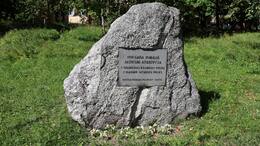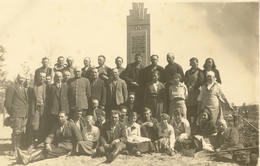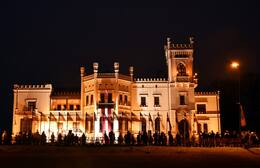Apie Latvijos Nepriklausomybės karą ir 1918 m. įvykius Alūksnėje
1918 m., kai vokiečių kariuomenė įžengė į Alūksnę, Latvijos šaulių batalionai atsitraukė į Sovietų Rusiją. Iki 1918 m. gruodžio pradžios buvo įtvirtintas vokiečių režimas ir vykdomos reorganizacijos. Vokietijai kapituliavus kare, bolševikai grįžo į Alūksnę ir atkūrė savo valdžią. Suomijos savanoriai taip pat kovojo Estijos armijos sudėtyje Latvijos Nepriklausomybės kare. 1919 m. vasario 21 d. Alūksnėje, netoli stoties, vyko įnirtingi mūšiai tarp bolševikų ir Suomijos savanorių pulko „Šiaurės berniukai“.
„1918 m. rudenį vokiečiai skubiai atsitraukė iš Alūksnės, nes Vokietijoje taip pat kilo revoliucija. Alūksnėje vėl kilo sovietų valdžia. Vokiečiai Bremžu gatvės parduotuvėje buvo palikę daug alkoholinių gėrimų butelių. Raudonieji šauliai nunešė butelius į kiemą ir daužė juos į akmenis. Pigūs likeriai, kuriuos vokiečiai paprastai mainė į valstiečių kiaušinius ir šoninę, dabar kvapniai tekėjo Vidus gatvės čiuožykla.“
Vykdomasis komitetas buvo įsikūręs Alūksnės pilyje. Kaip vadovaujančius darbuotojus prisimenu Zīlį, Samsoną, Egli, Dipānu Ernestą ir milicijos vadą Bukansą Augustą.“
„Vieną 1919 m. vasario vakarą buvo girdėti šautuvų ir kulkosvaidžių šūviai, pranašaujantys artėjantį frontą. Alūksnėje, Alsvikių gatvėje 11, mažame namelyje ant kalvos, gyvendami mažame kambarėlyje, mes su mama, seserimi stebėjome visus namo įvykius. Naktį šaudymo garsas vis artėjo. Kitą rytą patrankų sviediniai jau kaukė virš mūsų trobelės ir sprogo pievoje už pirties. Sniegas sprogimo angose pajuodo. Po pietų Alsvikių gatve atėjo ginkluoti suomių baltagvardiečiai. Su baltomis žieminėmis kepurėmis ir rudais žieminiais batais, užlenktais antsnukiais. Jie įėjo į mūsų varganą kambarį, apsidairė ir išėjo. Alūksnėje prasidėjo teroras. (..) Stoties kalvoje atsivėrė baisus vaizdas. Aplink sniege buvo daug kritusių žmonių, kai kurie net kinų tautybės sūnūs. (..) Alūksnės stotyje buvo aptiktas apgadintas šarvuotas traukinys. (..) Po kelių dienų baltiečiai vežė žuvusius didvyrius, sukrautus ant...“ rogėmis nuvežė į Alūksnės pilies aikštę, kur buvo palaidoti be karstų dviejose ilgose bendrose duobėse. (..) Vykdomasis komitetas evakavosi iš Alūksnės pilies. Raudonosios armijos daliniai taip pat paliko Alūksnę.“
Artūro Kļavos prisiminimai. Alūksnės muziejaus kolekcija. ANM 1701.
Artūras Kļava. Laiškas Alūksnės muziejui, 1961 12 21.
Susijusi laiko juosta
Susijusios vietos
Atminimo akmuo Alūksnės išvaduotojams
Įsikūręs Alūksnėje, Helēnas ir Alsviķu gatvių sankirtoje.
Atminimo akmuo buvo atidengtas 1999 m. gegužės 29 d., minint Alūksnės išvadavimo 80-ąsias metines. Akmens drožybos darbus atliko skulptorius Ainārs Zelčs.
1919 m. kovo 31 d. Tartu mieste buvo įkurta Šiaurės Latvijos brigada, kurios užduotis buvo išlaisvinti Vidžemę ir Latgalą. Brigadą sudarė jungtinis 1-asis Valmieros ir 2-asis Cėsių pėstininkų pulkai, vėliau ir Šiaurės Latvijos partizanų pulkas, du kavalerijos eskadrilės ir dvi artilerijos baterijos. Gegužės 26 d. šios pajėgos užėmė Valmierą, tačiau gegužės 27 d. 1-asis Valmieros pėstininkų pulkas kartu su 2-uoju Estijos kavalerijos pulku pradėjo puolimą Alūksnės kryptimi. Bolševikai nesugebėjo atremti tolesnių atakų, todėl 1919 m. gegužės 29 d. Alūksnė buvo išlaisvinta.
Atminimo akmuo suomių savanorių pulkui „Šiaurės berniukai“
Įsikūręs Alūksnėje, Jāņkalna gatvėje 52, šalia Alūksnės siaurojo geležinkelio stoties.
2019 m. vasario 23 d., minint Latvijos Nepriklausomybės karo šimtmetį, Nepriklausomybės kovos tradicijų asociacijos (Suomija) iniciatyva buvo sukurta speciali atminimo vieta Suomijos savanoriams, žuvusiems už Latvijos nepriklausomybę, pagerbti, kurioje istorinius įvykius liudija specialus riedulys ir informacinė lenta. Atminimo akmuo į Alūksnę atkeliavo iš Suomijos – Salpos linijos, kuri buvo nutiesta 1940–1944 m., siekiant apsaugoti rytinę Suomijos sieną. 1200 km ilgio Salpos linija yra viena žymiausių nepriklausomos Suomijos gynybos linijų, taip pat vienas stipriausių ir geriausiai išsilaikiusių tokio tipo gynybos statinių Europoje po Antrojo pasaulinio karo.
Į Alūksnę atgabentas akmuo simbolizuoja dviejų tautų – suomių ir latvių – kovą už savo nepriklausomybę. Suomijos savanorių pulkas „Šiaurės berniukai“ išvyko padėti latviams ginti naujosios Latvijos valstybės laisvę. 1919 m. vasario 21 d. „Šiaurės berniukai“ dalyvavo įnirtingose kovose Alūksnės (Marienburgo) apylinkėse. Po penkias valandas trukusių mūšių netoli Alūksnės geležinkelio stoties suomiai užėmė Alūksnę. Šiame mūšyje žuvo 23 suomių savanoriai, daugelis buvo sužeisti.
Paminklas Onos parapijos kariams, žuvusiems Pirmajame pasauliniame kare ir Latvijos išsivadavimo kare
Įsikūręs Anos parapijos Ezerinių kapinių centrinėje dalyje.
Kapinėse, kuriose laidojami nuo 1925 m., stovi paminklas, pastatytas iš Anos parapijos Sargybos skyriaus surinktų lėšomis ir 1933 m. atidengtas, skirtas Anos parapijos kariams, žuvusiems Pirmajame pasauliniame kare ir Latvijos išsivadavimo kare. Iki Antrojo pasaulinio karo paminklo priežiūra rūpinosi Anos parapijos sargybiniai, kurie kiekvieną sekmadienį eidavo į kapines ir, pagerbdami žuvusiuosius, dėdavo gėlių. 1940 m. lapkričio 18 d. paminklas buvo nugriautas, kulkų palikti pėdsakai vis dar matomi. Šiomis dienomis kapinėse kasmet rengiami Lačplėsio dienai skirti minėjimai.
2004 m. kapinėse atidaryta atminimo vieta 1941 ir 1949 m. politiškai represuotiems asmenims, o 2006 m. – atminimo lenta nacionaliniams partizanams.
Alūksnės muziejus
Alūksnės muziejus įsikūręs nacionalinės reikšmės architektūros paminkle – neogotikinėje Alūksnės Naujojoje pilyje, pastatytoje XIX a. pabaigoje. Muziejuje veikia paroda „Totalitarinio režimo aukų memorialinis kambarys“, kurioje pasakojama apie Alūksnės savivaldybės gyventojų likimus Sibire ir Tolimuosiuose Rytuose, o laikotarpis nuo priešistorės iki šių dienų susitinka Alūksnės istorijos ekspozicijoje „Amžių šventė“. Joje yra atskiras skyrius, skirtas 7-ojo Siguldos pėstininkų pulko indėliui į kariuomenę, kultūrą ir visuomenės gyvenimą. 7-ojo Siguldos pėstininkų pulko formavimas prasidėjo 1919 m. birželio 20 d. Naukšėnų dvare. Iš pradžių iš Šiaurės Latvijos brigados rezervinio bataliono buvo suformuota 22 karininkų ir 1580 kareivių kovinė grupė, pavadinta Dankersų divizija. Ji buvo įtraukta į 3-iojo Jelgavos pulko 2-ąjį batalioną. Rugpjūčio 23 d., padidėjus kuopų skaičiui, jis tapo 7-ojo Siguldos pėstininkų pulko dalimi. Dalyvavęs mūšiuose prieš Bermontą, 1920 m. sausio 5 d. pulkas buvo perkeltas į Latgalos frontą kovoti su bolševikais. Pasirašius taikos sutartį su Sovietų Rusija, pulkas saugojo rytinę Latvijos sieną. Latvijos nepriklausomybės kare žuvo daugiau nei 200 pulko karių, o 85 buvo apdovanoti Lačplėšio karo ordinu. 1921 m. 7-asis Siguldos pėstininkų pulkas buvo dislokuotas Alūksnėje. Pulko štabas buvo įsikūręs Alūksnės naujojoje pilyje. Po Antrojo pasaulinio karo pilį perėmė sovietų saugumo institucijos. Nuo šeštojo dešimtmečio pabaigos pilyje buvo įsikūrusios įvairios kultūros įstaigos: Vykdomojo komiteto Kultūros ir kinematografijos skyrius, pionierių namai, biblioteka, kino teatras ir muziejus.








